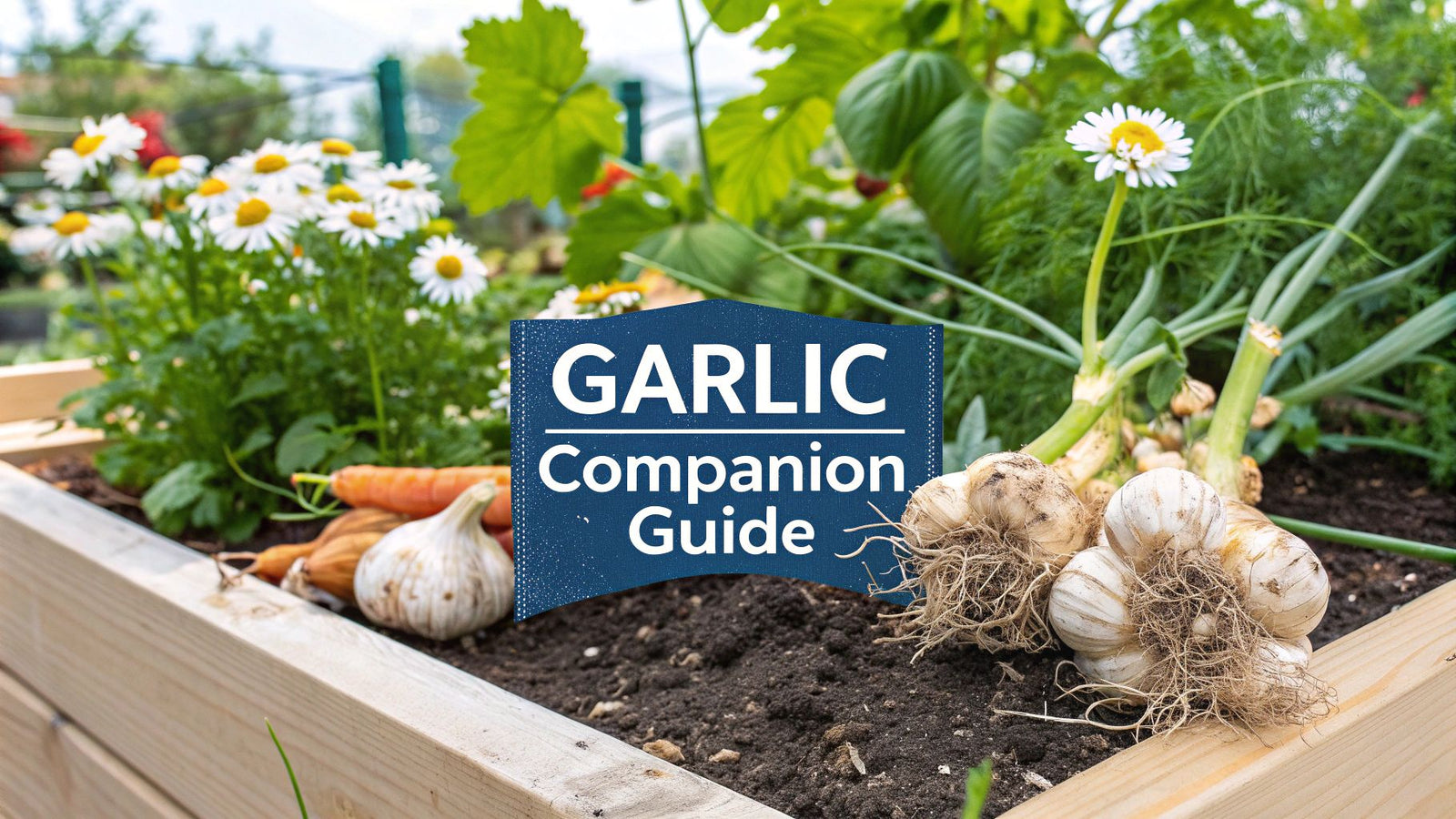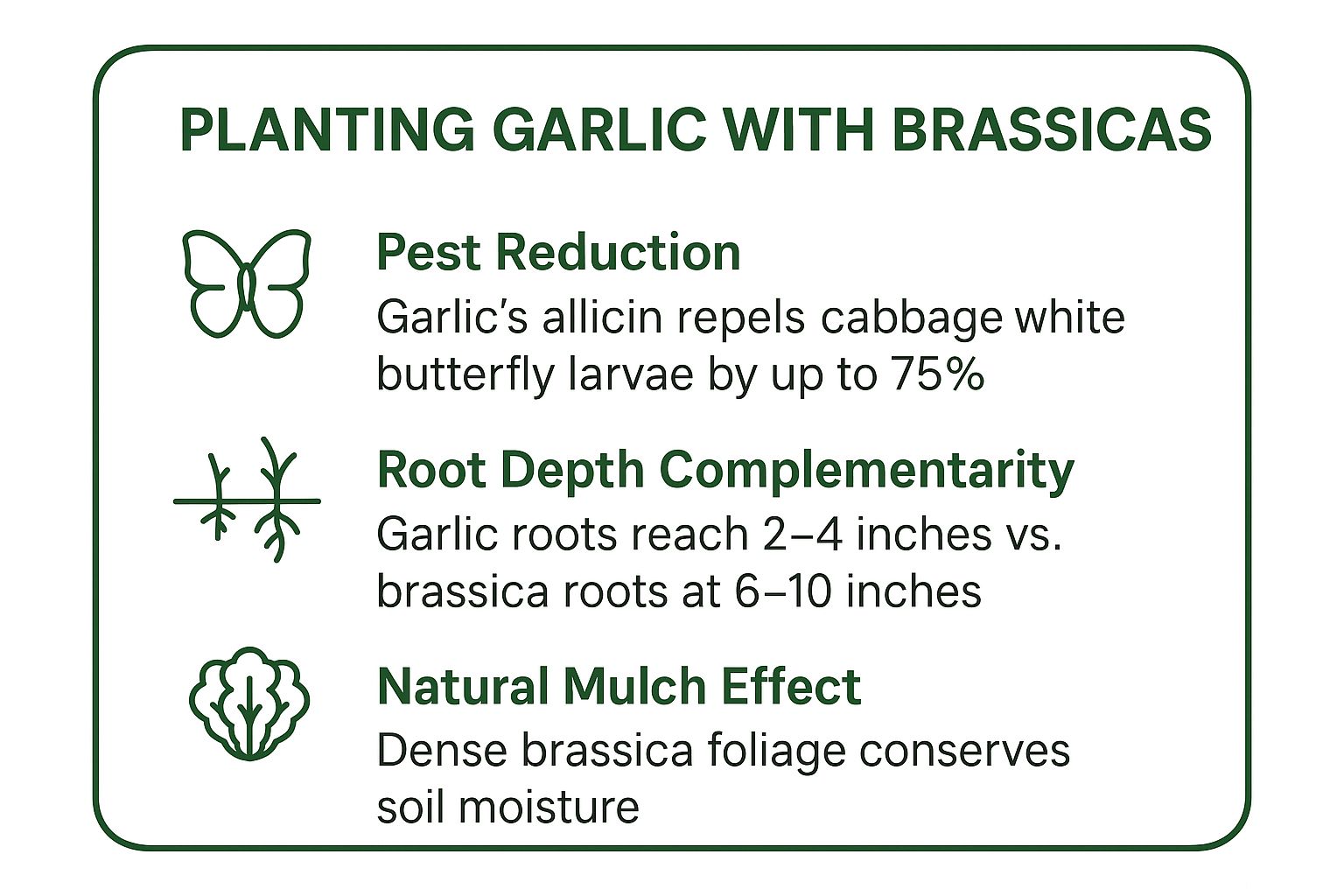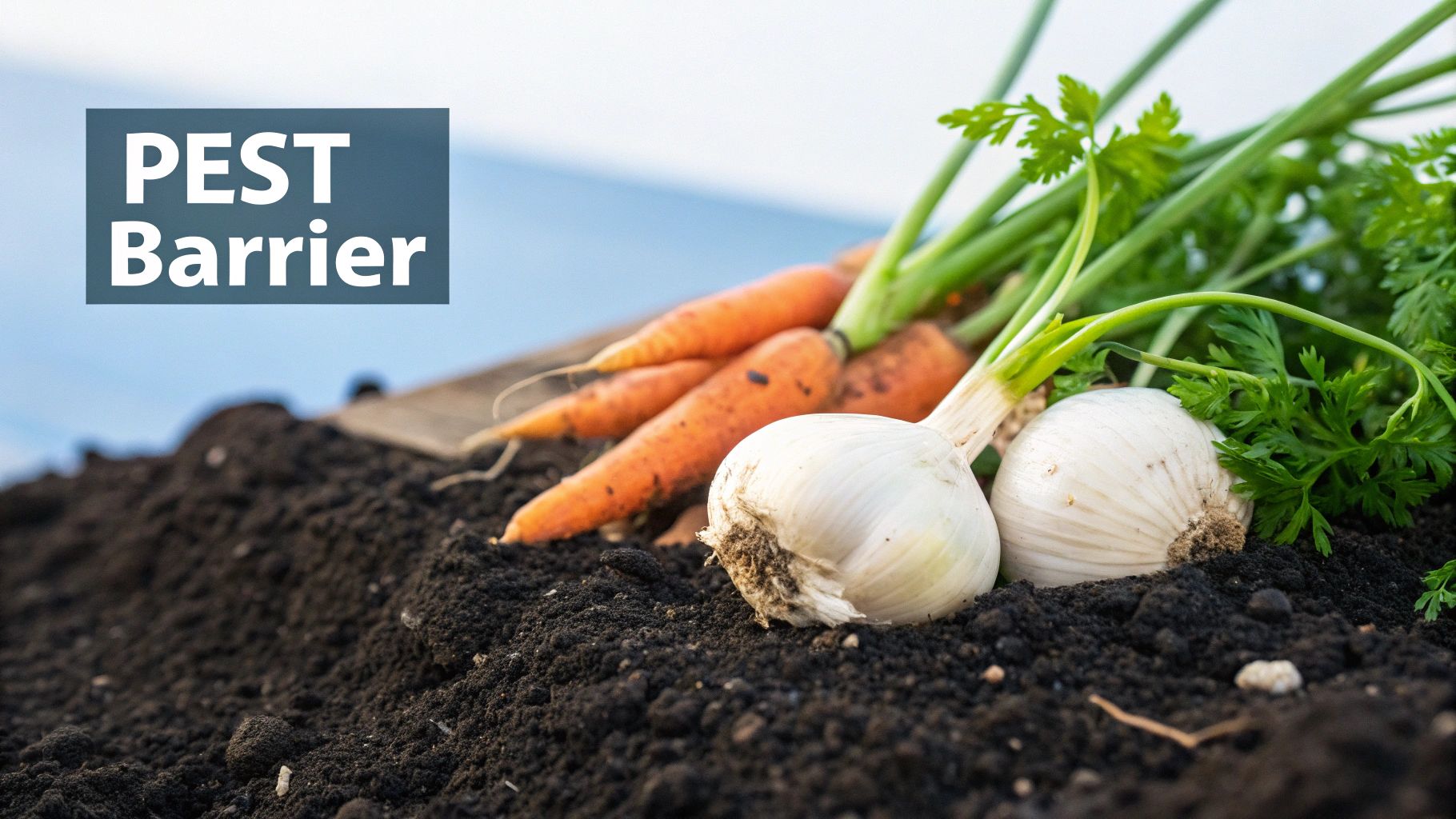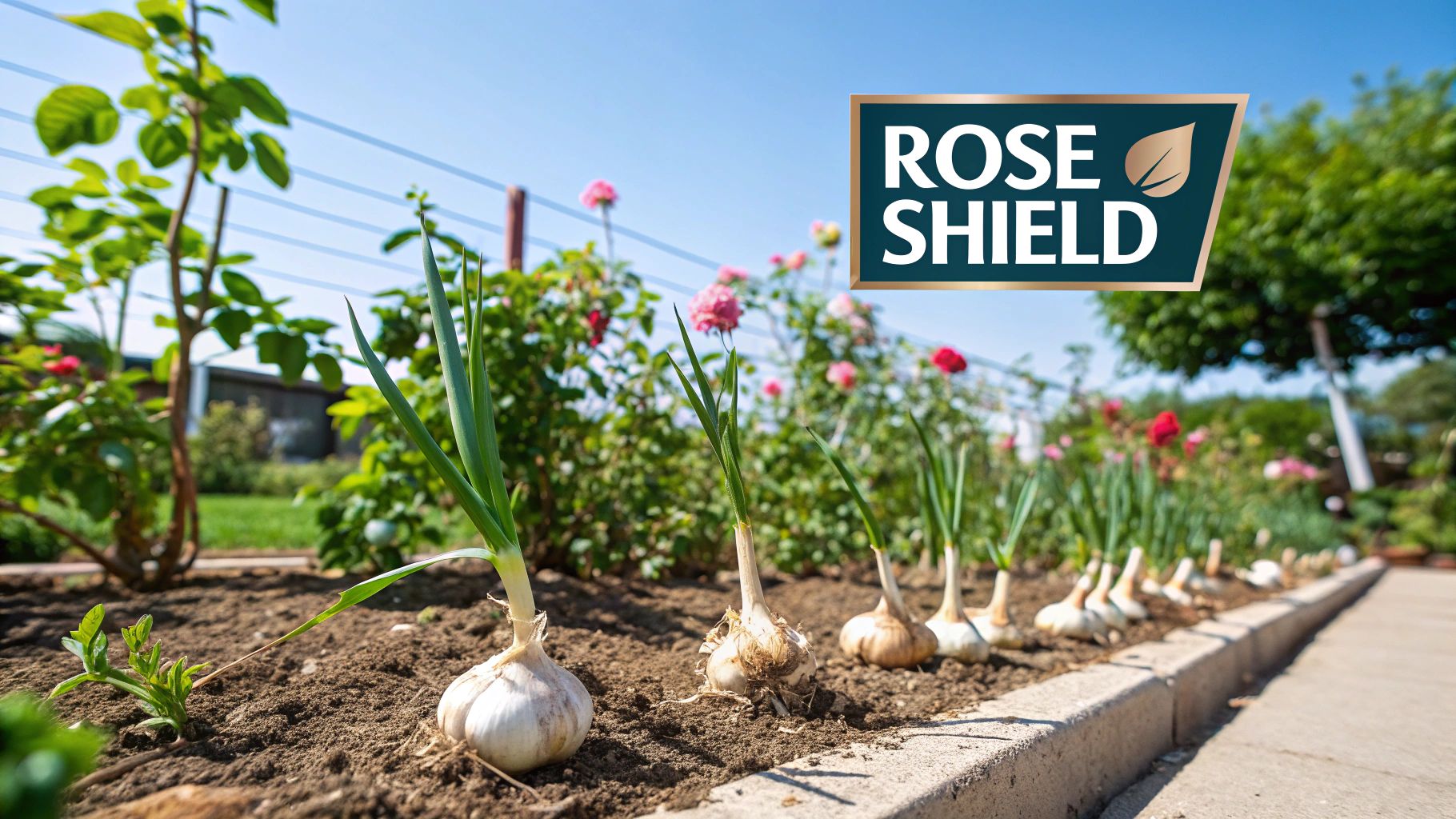
Welcome to the secret world of garden synergy, where the right partnerships can transform your vegetable patch into a thriving ecosystem. At the heart of this strategy is garlic, a powerful culinary staple and an even more potent garden ally. But what makes it so special? Garlic's strong aroma and natural sulfur compounds act as a living pest deterrent, warding off unwanted insects and diseases while enriching the soil.
Choosing the right companion plants for garlic isn't just about saving space; it's a strategic move to create a healthier, more productive, and self-regulating garden. This approach, known as companion planting, harnesses these natural benefits to protect more vulnerable crops, improve soil health, and even enhance the flavor of your harvest. By pairing garlic with compatible neighbors, you reduce the need for chemical pesticides and create a more balanced, resilient garden environment.
In this comprehensive guide, we will explore 8 of the most effective garlic companions, from leafy greens to fruit trees. We'll detail the science behind their success and provide actionable steps to implement these dynamic pairings. Prepare to see how these simple partnerships can lead to your most bountiful harvest yet.
1. Brassicas (Cabbage, Broccoli, Kale)
Pairing garlic with members of the brassica family, such as cabbage, broccoli, and kale, creates a powerful and synergistic relationship in the garden. This classic combination is one of the best examples of how thoughtful companion planting can lead to healthier plants and better yields. The core of this partnership lies in garlic’s natural pest-repelling abilities.
Garlic produces sulfurous compounds, most notably allicin, which are highly effective at deterring many of the most destructive brassica pests. Cabbage loopers, cabbage worms, diamondback moths, and even aphids are often confused or repelled by garlic's strong scent, making it harder for them to locate and feast on your valuable crops. This natural defense mechanism reduces the need for chemical pesticides and supports a thriving organic garden ecosystem.
Why This Pairing Works So Well
The benefits extend beyond just pest control. Brassicas and garlic have complementary growth habits that make them ideal bedfellows.
- Efficient Space Use: Most brassicas, like broccoli and kale, grow upright with a central stem, while garlic occupies the narrow space between them. This vertical layering allows you to maximize your planting area, a significant advantage in smaller plots or raised beds.
- Living Mulch: As brassicas mature, their broad leaves provide a "living mulch" effect. They shade the soil, which helps to suppress weed growth and conserve moisture, creating a more stable environment for garlic bulbs to develop.
- Root System Harmony: The two plant families occupy different soil depths. Garlic's roots are relatively shallow (2-4 inches), while brassica taproots dig deeper (6-10 inches), preventing direct competition for water and nutrients.
The infographic below summarizes the key data points that make this one of the most effective companion plants for garlic.

As the data shows, the benefits are quantifiable, from significant pest reduction to improved soil health through complementary root structures and moisture conservation.
How to Implement This Combination
To get the most out of this pairing, timing and spacing are crucial. Plant garlic cloves in the fall, and then transplant young brassica seedlings in the spring.
Pro Tip: Position brassica seedlings about 6 inches away from your rows of overwintered garlic. This gives both plants enough room to establish without interfering with each other's root systems.
For an in-depth visual guide on interplanting these crops, the following video offers practical demonstrations and tips for a successful harvest.
Many home gardeners find success by planting a row of garlic between every two rows of broccoli or cabbage. This "intercropping" layout ensures that the protective scent of garlic is distributed evenly throughout the patch. Consider using this pairing as part of a crop rotation plan to improve long-term soil health and prevent the buildup of soil-borne diseases.
2. Tomatoes
The pairing of garlic and tomatoes is a culinary classic that extends directly into the garden, creating a robust and mutually beneficial relationship. This partnership is celebrated in traditional Italian and Mediterranean farming, where gardeners have long known that planting garlic near tomatoes enhances the health and vigor of both crops. The core benefit comes from garlic's powerful aromatic properties, which help protect tomatoes from common garden pests.
Garlic's sulfurous compounds act as a natural deterrent for spider mites and aphids, two pests that frequently target tomato plants. The strong scent can confuse these pests, making it harder for them to find and damage your ripening fruit. This natural pest management system is a cornerstone of organic gardening, reducing reliance on chemical sprays and promoting a healthier garden environment. Some gardeners even report that interplanting with garlic improves the flavor of their tomatoes.

Why This Pairing Works So Well
Beyond pest control, this combination is a model of garden efficiency and symbiotic growth.
- Vertical Space Efficiency: Tomatoes grow vertically, especially when staked or caged, leaving the surrounding soil open. Garlic’s compact, upright growth habit allows it to thrive in this understory space without creating competition for sunlight, effectively doubling the productivity of a single patch of soil.
- Soil Health: Garlic is believed to release sulfur into the soil, which can help prevent certain soil-borne fungal diseases that might otherwise affect tomato roots. This contributes to a healthier root zone and more resilient plants.
- Distinct Root Zones: Similar to brassicas, the root systems do not directly compete. Garlic has shallow roots that occupy the top few inches of soil, while established tomato plants send roots much deeper in search of water and nutrients, allowing them to coexist peacefully.
For gardeners looking to expand their knowledge on complementary planting, you can find a wealth of information on which vegetable seeds go well together.
How to Implement This Combination
Proper spacing and timing are key to making this partnership flourish. Plant your garlic cloves in the fall or very early spring. Once the danger of frost has passed, you can transplant your young tomato seedlings into the bed.
Pro Tip: Plant garlic cloves in a circle about 8-12 inches away from where you plan to place your tomato transplant. This creates a protective aromatic barrier right where it's needed most without impeding the tomato's root development.
For determinate (bush) tomato varieties, this spacing is especially effective as the plant's spread is more contained, reducing the risk of shading out the garlic. Harvesting garlic scapes in late spring is also recommended; it redirects the plant's energy into bulb formation and prevents the garlic from competing with the rapidly growing tomato plant for resources. This strategy is frequently used by organic farms and even container gardeners growing cherry tomatoes alongside garlic in large pots.
3. Lettuce and Leafy Greens
Pairing garlic with lettuce and other leafy greens is a classic strategy, especially favored in intensive gardening systems where space is at a premium. This combination capitalizes on different growth habits and cycles to create a productive, multi-layered garden bed. Garlic’s pungent aroma provides excellent protection for tender greens, making it one of the most beneficial companion plants for garlic.
The strong sulfurous compounds in garlic help to deter common pests that plague leafy greens, such as aphids, spider mites, and even some slugs. By interplanting lettuce with garlic, you create a natural barrier that confuses these pests, reducing damage and the need for interventions. This allows your delicate greens to thrive and reach maturity without being targeted.
Why This Pairing Works So Well
The synergy between lettuce and garlic goes beyond pest control, focusing on efficient space utilization and complementary growth patterns.
- Shallow Root Systems: Lettuce and most leafy greens have shallow, fibrous root systems that spread out in the top few inches of soil. Garlic bulbs form deeper, which means the two plants do not compete for water or nutrients, allowing both to grow vigorously.
- Living Mulch: Planting lettuce around garlic acts as a "living mulch." The dense foliage shades the soil, suppressing weeds and conserving moisture. This is especially beneficial during warmer spring weather, as it keeps the soil cool for developing garlic bulbs.
- Quick Harvest Cycle: Many lettuce varieties mature in just 45-60 days. This allows you to sow and harvest several crops of lettuce in the space between your garlic rows before the garlic is even ready to be pulled in the summer.
This technique is frequently used by market gardeners who need to maximize yield from every square foot. They often use lettuce as a nurse crop, protecting the soil and young garlic shoots.
How to Implement This Combination
Success with this pairing relies on succession planting and strategic placement to make the most of the growing season.
Pro Tip: For a continuous harvest, sow new lettuce seeds between your garlic rows every two to three weeks. This ensures you always have fresh greens ready while your garlic continues to mature undisturbed.
Choose slow-bolt lettuce varieties if you plan to continue the pairing into late spring, as they are less likely to become bitter as temperatures rise. To harvest, simply cut the outer leaves of the lettuce plants, allowing the center to continue producing. This cut-and-come-again method extends your harvest season significantly without disturbing the garlic. Planting a dense mat of leaf lettuce around your garlic is one of the easiest ways to implement this highly effective partnership.
4. Carrots
Interplanting carrots and garlic establishes an outstanding underground partnership, creating a highly productive and pest-resistant garden bed. This combination is a perfect example of how different plant structures can work together to protect each other and improve growing conditions. The primary benefit comes from garlic's ability to shield carrots from their most persistent and destructive pests.
Garlic’s potent aroma, stemming from its sulfur compounds, acts as a natural insect repellent. This scent is particularly effective at masking the sweet smell of carrots, which confuses and deters the carrot rust fly. This troublesome pest lays its eggs near carrot crowns, and the resulting larvae tunnel into the roots, rendering them inedible. By planting garlic nearby, you create an aromatic barrier that significantly reduces the risk of infestation, supporting a healthier carrot harvest without chemical intervention.

Why This Pairing Works So Well
The synergy between carrots and garlic goes beyond just pest management, extending to efficient space and resource utilization below the soil.
- Complementary Root Zones: This pairing is a masterclass in avoiding competition. Carrots grow a long, deep taproot, while garlic develops a shallow, fibrous root system and bulb. They draw water and nutrients from different soil levels, allowing them to thrive in close proximity without conflict.
- Soil Aeration: The deep taproot of the carrot helps to break up and aerate compacted soil. This improved soil structure benefits the shallow-rooted garlic, allowing for better water penetration and easier bulb development.
- Maximized Garden Space: Because their primary growth happens at different depths, you can plant them closer together than you could with two competing root vegetables. This high-density planting is ideal for small gardens, square-foot gardening, and raised beds. Many biointensive farming methods feature garlic-carrot polycultures for this reason.
How to Implement This Combination
For the best results, plant your garlic in the fall to give it a head start. In the spring, once the garlic has sprouted and is well-established, you can sow your carrot seeds.
Pro Tip: When sowing carrots between garlic rows, thin the carrot seedlings carefully. Gently pull the unwanted seedlings straight up to avoid disturbing the developing roots and bulbs of their neighbors.
A common and effective layout is to plant two rows of carrots between each row of garlic. This ensures the protective scent is evenly distributed. For a continuous supply, consider succession planting your carrots every few weeks throughout the season. Choose shorter carrot varieties if you are working with shallow or heavy clay soil.
For more detailed information on cultivating this popular root vegetable, you can learn more about how to grow carrots successfully on homegrown-garden.com.
5. Roses
The garlic and rose pairing is a timeless combination, celebrated in ornamental and cottage gardens for its blend of beauty and practicality. This classic partnership leverages garlic's powerful natural properties to protect one of the garden's most beloved flowers. The core benefit stems from garlic's sulfur compounds, which act as a natural fungicide and pest deterrent.

Garlic's strong aroma confuses and repels common rose pests like aphids and Japanese beetles, reducing their ability to damage delicate blooms and foliage. Furthermore, studies suggest that the sulfur released into the soil can help suppress fungal diseases that plague roses, most notably black spot. This makes garlic one of the best companion plants for roses, creating a healthier, more resilient display with less need for chemical intervention.
Why This Pairing Works So Well
This historic combination, popularized in English cottage gardens, offers benefits that go beyond simple pest control, creating a symbiotic relationship.
- Natural Disease Suppression: Garlic's antifungal properties are its greatest asset in a rose bed. When planted nearby, it helps create a micro-environment less hospitable to fungal spores like black spot and powdery mildew.
- Aesthetic and Functional Design: The spiky, upright leaves of garlic provide a beautiful textural contrast to the soft, romantic foliage and blooms of roses. This pairing adds visual interest while serving a crucial protective function.
- Deterring Larger Pests: Beyond aphids, the pungent scent of garlic can also help deter larger garden visitors like deer and rabbits, who often browse on tender new rose shoots.
This combination is a cornerstone of organic rose care and is frequently used by specialists and public gardens to maintain vibrant, healthy roses sustainably.
How to Implement This Combination
For this pairing to succeed, strategic placement is key to providing protection without interfering with rose care.
Pro Tip: Plant garlic cloves in a ring about 12 to 18 inches away from the base of each rose bush. This keeps the garlic's protective scent close while staying clear of the root crown and areas disturbed during pruning.
Allowing some garlic plants to naturalize in the rose bed can provide perennial pest protection with minimal effort. You can also harvest most of your garlic and leave a few bulbs in the ground to sprout the following year. Combining garlic with other aromatic herbs like lavender or chives around your roses can amplify the pest-repelling effect and create a truly stunning and fragrant garden feature.
6. Peppers
Planting garlic alongside peppers, from sweet bells to fiery chiles, is a classic strategy used by gardeners to foster healthier, more productive plants. This pairing is especially beneficial for pepper plants, which can be susceptible to a variety of garden pests. The strong, sulfurous scent released by garlic acts as a natural deterrent, creating a protective barrier around your valuable pepper crop.
Garlic’s potent aroma is highly effective at confusing and repelling common pepper nemeses like aphids, spider mites, and flea beetles. This organic pest control method reduces the reliance on chemical interventions, making it a cornerstone of sustainable gardening practices. Many seasoned gardeners, especially those growing ingredients for salsa, plant garlic and peppers together for both convenience and mutual protection.
Why This Pairing Works So Well
The compatibility between garlic and peppers goes beyond pest management, extending to their growth habits and resource needs.
- Complementary Root Zones: Peppers have a moderately deep and spreading root system, while garlic’s roots are much shallower. This arrangement allows them to access water and nutrients from different soil levels, minimizing direct competition and ensuring both plants can thrive.
- Similar Sun Requirements: Both garlic and peppers flourish in full sun, making it easy to place them together in the sunniest parts of your garden without one overshadowing the other. Their growth cycles also align well in many climates.
- Convenient Harvest: For those cultivating a "salsa garden," interplanting these two essential ingredients simplifies harvesting. Everything you need for a fresh, flavorful batch is located in one convenient patch.
How to Implement This Combination
Proper timing and spacing are key to maximizing the benefits of this dynamic duo. Garlic is typically planted in the fall and harvested in mid-summer, while peppers are warm-season crops planted in late spring.
Pro Tip: When you transplant your young pepper seedlings into the garden in the spring, plant them near your rows of already-established garlic. Aim for a spacing of about 8-12 inches between the garlic and the base of each pepper plant to allow ample airflow and room for growth.
For an effective layout, consider planting a border of garlic around your entire pepper patch. This creates a powerful aromatic shield that pests must cross to reach the peppers. Alternatively, intercropping a row of garlic between every row of peppers ensures the protective scent is evenly distributed. This method is one of the best ways to integrate companion plants for garlic into a productive vegetable garden.
7. Fruit Trees (Apple, Cherry, Peach)
Planting garlic at the base of fruit trees like apples, cherries, and peaches is a classic permaculture technique that creates a robust, multi-layered garden ecosystem. This approach, often seen in food forest designs, uses garlic as a protective understory plant. Its primary role is to ward off common orchard pests while making efficient use of vertical space.
Garlic's strong, sulfurous aroma is a powerful natural deterrent for destructive insects. It has been shown to confuse and repel pests like apple codling moths, borers, and even deer, which dislike its pungent scent. This natural pest management system protects the health of your fruit trees and reduces the reliance on chemical sprays, which is a major advantage for organic growers. This makes garlic one of the most functional companion plants for garlic and fruit tree guilds.
Why This Pairing Works So Well
The relationship between garlic and fruit trees is a perfect example of a symbiotic guild, where different plants support each other's growth.
- Pest Protection: Garlic is particularly effective against borers, which can cause significant damage to the trunks of young peach and cherry trees. The scent masks the tree's natural aroma, making it harder for pests to find their target.
- Fungal Suppression: The sulfur compounds in garlic have antifungal properties that can help suppress certain soil-borne pathogens, contributing to a healthier root zone for the tree.
- Efficient Nutrient Use: Fruit trees have deep, extensive root systems that draw nutrients from lower soil levels. Garlic's shallow roots occupy the top few inches, meaning there is minimal competition for water and nutrients.
Many organic orchards successfully use garlic as a core component of their integrated pest management strategy, demonstrating its effectiveness on a larger scale.
How to Implement This Combination
For this pairing to succeed, placement and timing are key. Plant garlic cloves in the fall around the base of your fruit trees.
Pro Tip: Plant your garlic in a ring around the tree's "drip line," which is the outer circumference of its canopy. This area receives a good balance of sun and rain, and it's where the tree's feeder roots are most active.
For more ideas on building a productive orchard ecosystem, you can explore a complete fruit tree companion planting chart on homegrown-garden.com.
Planting in this zone ensures the garlic receives adequate light before the tree fully leafs out in late spring. Avoid planting directly against the trunk, as this can trap moisture and hinder air circulation. Combining garlic with other beneficial understory plants like comfrey or chives can further enhance the health and productivity of your mini-orchard.
8. Strawberries
Pairing strawberries with garlic creates a highly effective, ground-level partnership that protects one of the most beloved garden fruits. Strawberries are notoriously susceptible to pests that can quickly ruin a harvest, and garlic acts as a powerful natural guardian. This combination is ideal for gardeners looking to grow sweet, unblemished berries without resorting to chemical interventions.
The core benefit of this pairing comes from garlic's strong, sulfurous aroma, which naturally repels or confuses many of the most damaging strawberry pests. Slugs, snails, and certain species of aphids that often plague strawberry patches are deterred by the pungent scent. This defensive shield allows strawberry plants to thrive and produce fruit with significantly less pest pressure, making garlic one of the best companion plants for a healthy berry patch.
Why This Pairing Works So Well
The synergistic relationship between garlic and strawberries extends beyond pest control, encompassing efficient space management and soil health.
- Pest Protection: Garlic is a proven deterrent for slugs and snails, which are major threats to ripening strawberries. Its scent masks the sweet smell of the berries, making them harder for pests to locate.
- Fungal Disease Suppression: The sulfur compounds in garlic have natural anti-fungal properties. Planting garlic nearby may help reduce the incidence of common strawberry diseases like gray mold (Botrytis cinerea) by improving air circulation and creating a less favorable environment for fungal spores.
- Minimal Competition: Both plants have shallow root systems and similar needs for sunlight and well-drained soil. When spaced correctly, they can coexist in the same bed without competing aggressively for resources, making them excellent bedfellows.
Many organic berry farms and home gardeners successfully integrate garlic into their strawberry beds, planting cloves around the perimeter or directly between the plants to create a protective barrier.
How to Implement This Combination
Proper spacing and timing are key to maximizing the benefits of this classic garden duo. The goal is to protect the berries without overcrowding them.
Pro Tip: Plant garlic cloves in the fall after your strawberry plants have finished their main fruiting season. This gives the garlic a head start to establish its root system and begin offering protective benefits by the time the strawberries become active in spring.
For established strawberry patches, plant individual garlic cloves about 8 to 12 inches away from the crown of each strawberry plant. This can be done along the rows or in a grid pattern throughout the bed. This spacing ensures both plants have adequate room to grow, preventing resource competition while keeping the garlic's protective scent distributed. This method is particularly useful during strawberry bed renovation, as new garlic can be planted alongside new strawberry runners.
Companion Planting Compatibility Matrix for Garlic
| Companion Plants | Implementation Complexity 🔄 | Resource Requirements ⚡ | Expected Outcomes 📊 | Ideal Use Cases 💡 | Key Advantages ⭐ |
|---|---|---|---|---|---|
| Brassicas (Cabbage, Broccoli, Kale) | Medium: spacing and harvest timing management | Moderate: soil compatibility, pest management | High pest reduction and efficient space use | Cool-season gardens, rotation systems | Strong pest repellent; natural mulch effect |
| Tomatoes | Medium-High: managing shading and watering | Moderate-High: adjustments for differing needs | Improved flavor, pest reduction, vertical space | Warm-season gardens, containers, organic beds | Pest and disease deterrence; enhanced flavor |
| Lettuce and Leafy Greens | Low: quick maturity and shallow roots | Low: minimal input, frequent plantings | Fast harvests, multiple planting cycles | Cool-season beds, intensive intercropping | Non-competitive roots; efficient space use |
| Carrots | Medium: careful thinning and soil prep | Moderate: well-draining soil and root care | Strong pest protection; soil structure benefits | Root vegetable beds, biointensive gardening | Deep root complementarity; high pest reduction |
| Roses | Medium-High: annual garlic cycle with perennials | Moderate: planting distance and timing | Pest and disease reduction in ornamentals | Ornamental gardens, sustainable rose care | Fungicidal effects; dual ornamental and edible value |
| Peppers | Medium: watering and harvest timing challenges | Moderate: pest control and spacing considerations | Pest deterrence; flavor and heat enhancement | Warm-season gardens, greenhouses, salsa gardens | Pest protection; compatible growth habits |
| Fruit Trees (Apple, Cherry, Peach) | Medium-High: managing shade and root competition | Moderate: understory planting and orchard layout | Pest control and fungal disease prevention | Orchards, permaculture guilds | Efficient understory use; integrated pest management |
| Strawberries | Medium: managing runners and root disturbance | Moderate: spacing and timing coordination | Strong pest reduction; compatible growth habits | Berry patches, container gardening, organic farms | Effective slug and aphid deterrent; space-efficient |
Cultivating Harmony in Your Home Garden
As we have explored throughout this guide, the practice of companion planting is much more than a traditional gardening tale; it is a strategic approach to creating a dynamic, self-sustaining ecosystem right in your backyard. Integrating the right companion plants for garlic transforms your garden from a simple collection of individual plants into a collaborative community where each member contributes to the whole. By thoughtfully arranging your garden beds, you leverage garlic's powerful properties to protect and enhance its neighbors.
The benefits are clear and compelling. From the pungent sulfur compounds in garlic that repel aphids from your precious roses and brassicas, to its ability to confuse carrot rust flies, these partnerships are built on a foundation of natural defense. This means less reliance on chemical pesticides and a healthier environment for beneficial insects, pollinators, and your family. Remember the core principle: garlic acts as a guardian, and in return, its companions help maximize your use of space and resources.
Key Takeaways for Your Garlic Garden
To successfully implement these strategies, keep these essential points in mind:
- Pest Deterrence is Paramount: Garlic is a frontline defender. Plant it near susceptible crops like cabbage, broccoli, kale, and even fruit trees to ward off common pests like cabbage worms, aphids, and Japanese beetles.
- Space Maximization is Smart: Utilize the "in-between" spaces. Interplanting fast-growing lettuce or spinach among your slow-maturing garlic allows for continuous harvests from the same plot of land, a perfect technique for small or urban gardens.
- Soil Health Matters: While garlic deters many pests, it also has antifungal properties. Pairing it with plants susceptible to fungal diseases, such as strawberries or tomatoes, can contribute to a healthier root environment and more robust growth.
- Observe and Adapt: Your garden is a unique microclimate. Pay close attention to how your specific pairings perform. What thrives in one garden might need adjustment in another. Keep a simple garden journal to track your successes and learning opportunities for next season.
Your Actionable Next Steps
Feeling inspired? Don't just read about it, do it. Start small. Choose just one or two of the pairings we've discussed, like planting a border of garlic around your strawberry patch or interspersing it between your tomato plants. This focused approach allows you to observe the direct impact without feeling overwhelmed. Plan your garden layout on paper first, considering the mature size and sunlight needs of each plant. This simple act of planning is your blueprint for a harmonious and productive garden. Mastering the art of companion planting with garlic is a journey that rewards you with healthier plants, bigger harvests, and a deeper connection to the natural rhythms of your garden.
Ready to build your own thriving garden ecosystem? Find everything you need, from premium heirloom garlic bulbs to the seeds for all its perfect partners, at Homegrown Garden. We provide high-quality, organic-certified seeds and expert resources to help you cultivate a garden that is both beautiful and bountiful. Start your journey toward a more harmonious garden today at Homegrown Garden.



